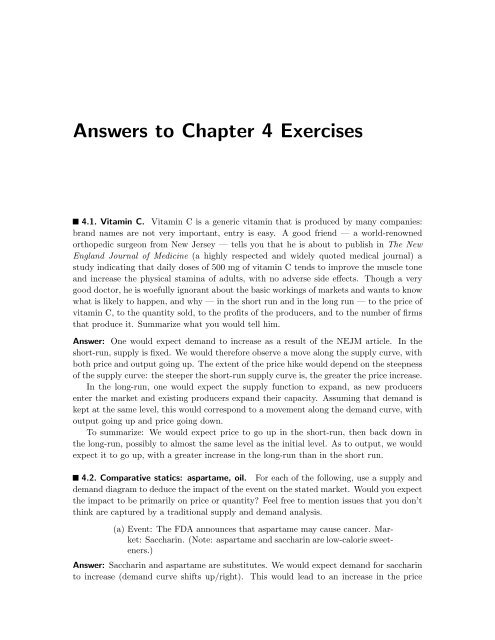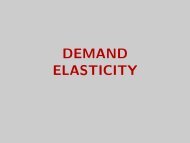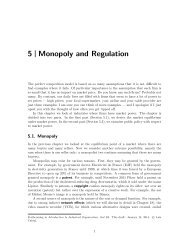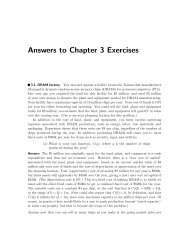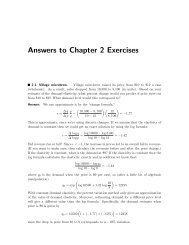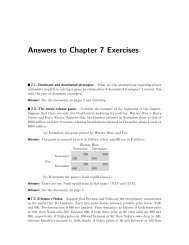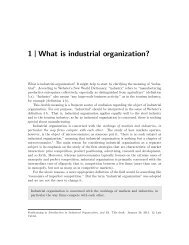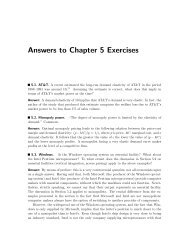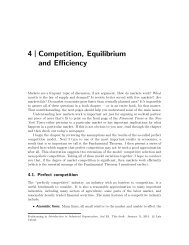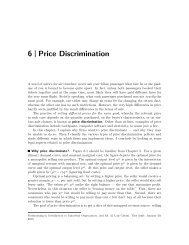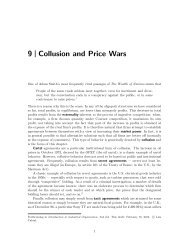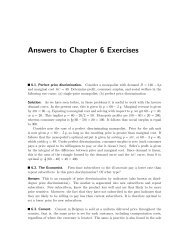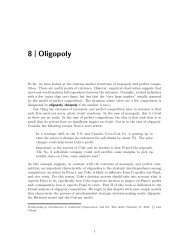Answers to Chapter 4 Exercises - Luiscabral.net
Answers to Chapter 4 Exercises - Luiscabral.net
Answers to Chapter 4 Exercises - Luiscabral.net
- No tags were found...
Create successful ePaper yourself
Turn your PDF publications into a flip-book with our unique Google optimized e-Paper software.
<strong>Answers</strong> <strong>to</strong> <strong>Chapter</strong> 4 <strong>Exercises</strong>4.1. Vitamin C. Vitamin C is a generic vitamin that is produced by many companies:brand names are not very important, entry is easy. A good friend — a world-renownedorthopedic surgeon from New Jersey — tells you that he is about <strong>to</strong> publish in The NewEngland Journal of Medicine (a highly respected and widely quoted medical journal) astudy indicating that daily doses of 500 mg of vitamin C tends <strong>to</strong> improve the muscle <strong>to</strong>neand increase the physical stamina of adults, with no adverse side e↵ects. Though a verygood doc<strong>to</strong>r, he is woefully ignorant about the basic workings of markets and wants <strong>to</strong> knowwhat is likely <strong>to</strong> happen, and why — in the short run and in the long run — <strong>to</strong> the price ofvitamin C, <strong>to</strong> the quantity sold, <strong>to</strong> the profits of the producers, and <strong>to</strong> the number of firmsthat produce it. Summarize what you would tell him.Answer: One would expect demand <strong>to</strong> increase as a result of the NEJM article. In theshort-run, supply is fixed. We would therefore observe a move along the supply curve, withboth price and output going up. The extent of the price hike would depend on the steepnessof the supply curve: the steeper the short-run supply curve is, the greater the price increase.In the long-run, one would expect the supply function <strong>to</strong> expand, as new producersenter the market and existing producers expand their capacity. Assuming that demand iskept at the same level, this would correspond <strong>to</strong> a movement along the demand curve, withoutput going up and price going down.To summarize: We would expect price <strong>to</strong> go up in the short-run, then back down inthe long-run, possibly <strong>to</strong> almost the same level as the initial level. As <strong>to</strong> output, we wouldexpect it <strong>to</strong> go up, with a greater increase in the long-run than in the short run.4.2. Comparative statics: aspartame, oil. For each of the following, use a supply anddemand diagram <strong>to</strong> deduce the impact of the event on the stated market. Would you expectthe impact <strong>to</strong> be primarily on price or quantity? Feel free <strong>to</strong> mention issues that you don’tthink are captured by a traditional supply and demand analysis.(a) Event: The FDA announces that aspartame may cause cancer. Market:Saccharin. (Note: aspartame and saccharin are low-calorie sweeteners.)Answer: Saccharin and aspartame are substitutes. We would expect demand for saccharin<strong>to</strong> increase (demand curve shifts up/right). This would lead <strong>to</strong> an increase in the price
of saccharin and the quantity produced. The supply is likely <strong>to</strong> be fairly elastic (flat) asthere are several producers. Thus we would expect the main impact <strong>to</strong> be on quantity. Thesupply curve is expected <strong>to</strong> be flat particularly in the long-run. For example, suppliers ofother related products can convert their production capacity <strong>to</strong> saccharin if the price were<strong>to</strong> remain at high levels for very long.(b) Event: Oil price increases. Market: California electricity.Answer: Oil is an input <strong>to</strong> some of the generating plants. This implies an upward shift inmarginal cost of some plants (those that use oil). If the plants are the marginal ones (thosedetermining the price) then price will rise. Since demand is inelastic, the primary impactwill be on price. Otherwise, there’s no impact: these plants simply make less money. Someof you may have also noticed that oil and electricity are substitutes (in the long run). Thisimplies that you can also have a shift of the demand <strong>to</strong> the right. This increases the priceeven further, and makes the overall e↵ect on quantity ambiguous.4.3. Comparative statics: hotels, umbrellas. For each of the following, use a supplyand demand diagram <strong>to</strong> deduce the impact of the event on the stated market. Would youexpect the impact <strong>to</strong> be primarily on price or quantity? Feel free <strong>to</strong> mention issues thatyou don’t think are captured by a traditional supply and demand analysis.(a) Event: The Champions League final in taking place in Madrid. Market:Madrid hotels.Answer: The Madrid final increases the demand for hotel space, shifting the demand curve<strong>to</strong> the right. This leads <strong>to</strong> a higher price and output level. The supply curve is veryinelastic in the short-run. We would thus expect the impact of the final <strong>to</strong> be felt primarilyon price, not output level. However, if the event were announced as a permanent fixture(the final takes place in Madrid every year), then in the long run supply would respond <strong>to</strong>this increased demand by shifting <strong>to</strong> the right, in which case the impact on price would belower.(b) Event: there is an unusually rainy winter in Lisbon. Market: umbrellasin Lisbon.Answer: Rain implies a shift in demand <strong>to</strong> the right, leading <strong>to</strong> higher price and outputlevels. Moreover, the supply of umbrellas is likely <strong>to</strong> be relatively flat, except perhaps inthe very short run. The idea is that it is not going <strong>to</strong> be a rainy winter everywhere. Forexample, suppose that it is not so rainy in Spain. Then it will be easy <strong>to</strong> import umbrellas<strong>to</strong> Spain <strong>to</strong> Lisbon and thus compensate for the demand shift. As a result, most of thee↵ect of the rain is <strong>to</strong> increase the number of umbrellas, not so much the price of umbrellas.4.4. Kidney transplants. Suppose that in a given state — let’s call it state X —a few recent kidney transplant malpractice suits have led <strong>to</strong> punitive damage awards ofunprecedented levels. What impact do you expect this <strong>to</strong> have in the market for kidneytransplant services in state X? To the extent that you can, and making the necessaryassumptions as you go along, indicate the expected e↵ects on price and quantity; the relativemagnitude of these e↵ects; and any possible di↵erences between short-run and long-run2
e↵ects.Answer: The possibility of expensive lawsuits will lead doc<strong>to</strong>rs <strong>to</strong> take on more insurance,and premiums for such insurance will increase. This implies an upward shift in the supplycurve as each doc<strong>to</strong>r now charges more per unit of service. Given a demand curve, thisimmediately leads <strong>to</strong> an increase in price and a decrease in quantity. Depending on thenature of demand, the demand elasticity may be greater or smaller in absolute value. Asa general rule, demand for medicines and medical services tends <strong>to</strong> be relatively inelastic.However, while demand for kidney transplants is relatively inelastic, the demand for kidneytransplants in state X is probably fairly elastic: one can always travel <strong>to</strong> a neighboringstate. I would thus expect the main e↵ect <strong>to</strong> be on quantity: state X will likely become astate with very few kidney transplants.In the longer run, two things will happen. First, <strong>to</strong> the extent that demand is downwardsloping, doc<strong>to</strong>rs are now receiving a lower <strong>net</strong> price per unit of medical services (the rest isinsurance premiums). In the long run, doc<strong>to</strong>rs will be more flexible regarding their locationand it is expected that some will move out of state. This implies a further shift in the supplycurve, this time <strong>to</strong> the left. Second, buyers are also likely <strong>to</strong> be more flexible, which impliesa shift in the demand curve <strong>to</strong> the left. Both movements imply a decrease in quantity. Thee↵ect on price is unclear: the shift in supply leads <strong>to</strong> an increase in price, whereas the shiftin demand leads <strong>to</strong> a decrease in price.4.5. Book publishing. The technology of book publishing is characterized by a high fixedcost (typesetting the book) and a very low marginal cost (printing). Prices are set at muchhigher levels than marginal cost. However, book publishing yields a normal rate of return.Are these facts consistent with profit maximizing behavior by publishers? Which model doyou think describes this industry best?Answer: The model of monopolistic competition is probably the best approximation <strong>to</strong>describing this industry. The model of monopolistic competition shows that price-making,profit-maximizing behavior is consistent with a zero-profit long-run equilibrium. The strongscale economies in book publishing imply that the gap between price and marginal cost isparticularly high.4.6. Laundry detergent. The market for laundry detergent is monopolistically competitive.Each firm owns one brand, and each brand has e↵ectively di↵erentiated itself so thatis has some market power (i.e., faces a downward sloping demand curve). Still, no brandearns economic profits, because entry causes the demand for each brand <strong>to</strong> shift in until theseller can just break even. All firms have identical cost functions, which are U-shaped.Suppose that the government does a study on detergents and finds out they are all alike.The public is notified of these findings and suddenly drops allegiance <strong>to</strong> any brand. Whathappens <strong>to</strong> price when this product that was brand-di↵erentiated becomes a commodity?What happens <strong>to</strong> <strong>to</strong>tal sales? What happens <strong>to</strong> the number of firms in the market?Answer: Based on the information provided, it seems that the initial situation in this marketis like the long-run equilibrium of the monopolistic competition model; see Figure 6.3. Thegovernment’s announcement has turned a di↵erentiated product in<strong>to</strong> a homogeneous one.3
In terms of the graph in Figure 6.3, this implies a flattening of the demand curve faced byeach firm and a new long-run equilibrium where d (now horizontal) is tangent <strong>to</strong> the ACcurve. At this new long-run equilibrium, price is given by p 0 and each firm’s output isLRgiven by q 0 . LRClearly, the new equilibrium implies a lower price and a higher output per firm: p 0 < LRp LRand q 0 >q .LR LRSuppose that price were <strong>to</strong> drop from p LR<strong>to</strong> p 0 without changing the degree of productLRdi↵erentiation or the number of firms. This would imply an output per firm equal <strong>to</strong> q 0 , SRwhere q 0 is greater than q but lower than SR LR q0 . If we take in<strong>to</strong> account the disappearanceLRof product di↵erentiation (and continue with the same number of firms), then the outputper firm would be less than q 0 . Whatever the exact value is, each firm would be losingSRmoney (p 0 < AC). Therefore, in the post-announcement long-run equilibrium, some firmsLRwill need <strong>to</strong> exit the market.Finally, it is not clear what will happen <strong>to</strong> <strong>to</strong>tal output. On the one hand, each firm’soutput goes up. On the other hand, the number of firms goes down. Which e↵ect dominatesdepends on how consumers value product di↵erentiation and how the demand curve shiftsas a result of the government announcement.4.7. T-shirt printing. The cus<strong>to</strong>m T-shirt printing business has many competi<strong>to</strong>rs, sothat the perfect competition model may be considered a good approximation. Currentlythe market demand curve is given by Q = 120 1.5 p, whereas the market supply is givenby Q = 20 + 2 p.(a) Determine the market equilibriumAnswer: Equilibrium price is given by the equality120 1.5 p = 20 + 2 pwhich implies p = 40. Substituting in<strong>to</strong> the demand curve (or the supply curve, it doesn’tmatter), we get Q = 60.Suppose there is a T-shirt craze that increases demand by 10% (that is, for each price,demand is now 10% greater than it was before the price increase).(b) Determine the new demand curve.Answer: The new demand curve is obtained by multiplying the initial one by 1.1=1+10%:Q =1.1 ⇥(120 1.5 p) = 132 1.65 p(c) Determine the change in equilibrium quantity.Answer: Equilibrium price is given by the equality132 1.65 p = 20 + 2 pwhich implies p = 41.64. Substituting for p in the demand curve we get Q = 63.29. Notethat the initial value of Q was 60. We thus have an increase of 3.29/60, or 5.48%4
(d) If your answer <strong>to</strong> the previous question is di↵erent from 10%, explainthe di↵erence in values.Answer: The shift of the demand curve is partly reflected in an increase in Q and partlyin an increase in p. If the supply curve were flat, then the increase in equilibrium Q wouldbe exactly 10%. Since the supply curve is upward sloping, the increase is less than 10%Now go back <strong>to</strong> the initial demand curve and suppose there is an increase in the cost ofblank T-shirts, an essential input in<strong>to</strong> the business of selling cus<strong>to</strong>m T-shirts. Specifically,for each unit by each supplier, the production cost goes up by 10%.(e) Determine the new supply curve.Answer: Since we have a proportional vertical increase in the supply curve (that is, whenthe supply curve is expressed in the inverse form with price units as a function of quantityunits), we must first find the inverse supply curve, then multiply it by 1.1, then invert itback again <strong>to</strong> obtain the (direct) supply curve. From Q = 20 + 2 p we getp = 10.5 QThe new inverse supply curve is thus given byp =1.1 ⇥ 10 + .5 Q = 11 + .55 Qwhich can be inverted in<strong>to</strong>Q =20 + 1.82 p(f) Determine the change in equilibrium price.Answer: The new equilibrium price is given by the equality120 1.5 p = 20 + 2 pwhich implies p = 42.17. This corresponds <strong>to</strong> an increase of 2.17/40 = 5.42%.(g) If your answer <strong>to</strong> the previous question is di↵erent from 10%, explainthe di↵erence in values.Answer: The answer is similar <strong>to</strong> that of question (d). If the demand curve where perfectlyinelastic, then the shift in the supply curve would imply a change in equilibrium price ofexactly 10%. Since the demand curve is downward sloping, the upward shift in the supplycurve implies an increase in prices as well as a decrease in equilibrium quantity. For thisreason, the increase in equilibrium price is lower than the shift in the supply curve.4.8. Sales tax. Consider an industry with market demand Q = 540 20 p and marketsupply Q = 100 + 10 p. Determine the equilibrium price and quantity. Suppose the governmentimposes a tax of $5 per unit <strong>to</strong> be paid by consumers. What is the impact onequilibrium price and quantity? What if the sales tax is paid by the seller instead of thebuyer?5
Answer: We derive equilibrium p and Q by solving the supply and demand system ofequations. Since both are written in terms of Q, this is a relatively easy task:or simply540 20 p = 100 + 10 pp =540 10020 + 10 = 14.6Substituting for p in the supply equation, we getQ = 100 + 10 ⇥ 14.6 = 246.6Suppose each consumer must pay a $5 tax. This means each consumer is willing <strong>to</strong> pay 5dollars less for each unit then before. Consumer gross willingness <strong>to</strong> pay is given by theinverse demand curve. From Q = 540 20 p, we getp = 54020120 Q = 27 120 QIt follows that, with the sales tax, willingness <strong>to</strong> pay is now given by✓p = 275 = 22or, <strong>to</strong> put in the same form as initially,◆120 Q120 QQ = 44020 pThe new equilibrium is determined by the intersection of the demand and the new supplycurve:440 20 p = 100 + 10 por simplyp =440 10020 + 10 = 11.3Substituting for p in the supply equation, we getQ = 100 + 10 ⇥ 11.3 = 213.3Notice that the price e↵ectively paid by consumers is 11.3 + 5 = 16.3 This represents anincrease of 1.6 with respect <strong>to</strong> the initial price, which is considerably less than 5. Why?because some of the tax’s burden is taken by sellers, who now receive a price of 11.3, a dropof 3.3. (Note that, as expected, 1.6+3.3=5.) Suppose instead that sellers must pay the $5tax. This means that if a seller was willing <strong>to</strong> sell for a price p, it is now willing <strong>to</strong> sell forp + 5, so that the <strong>net</strong> price is the same p as before. What is then the new supply function?It helps <strong>to</strong> solve it in terms of p as a function of Q:p = 10010 + 1 10 Q6
The new supply curve is therefore given by✓p = 10 + 1 ◆10 Q +5= 5+ 110 Qor, <strong>to</strong> put in the same form as initially,Q = 50 + 10 pThe new equilibrium is determined by the intersection of the demand and the new supplycurve:540 20 p = 50 + 10 por simplyp =540 5020 + 10 = 16.3Substituting for p in the supply equation, we getQ = 50 + 10 ⇥ 16.3 = 213.3As we compare this equilibrium <strong>to</strong> the case when the tax is paid by the buyer, we realizethat: (a) <strong>to</strong>tal output is the same; (b) the price e↵ectively paid by the buyer is the same;(c) the price price e↵ectively received by the seller is the same. We have just stumbled in<strong>to</strong>an important result from the economic theory of taxation: the burden of a sales tax doesnot depend on who actually pays the tax!Extra credit: What then determines the relative burden of a sales tax that falls onbuyers and on sellers?4.9. Sales tax with steeper demand. Consider again Exercise 4.8. Suppose that demandis instead given by Q = 276 2 p.(a) Show that the equilibrium levels of p and q are the same as in theinitial equilibrium of Exercise 4.8.Answer: Equilibrium price is determined byor simply236 2 p = 100 + 10 pp =276 1002 + 10Substituting for p in the supply equation, we get= 14.6Q = 100 + 10 ⇥ 14.6 = 246.6the same values as in the initial equilibrium in Exercise 4.8.(b) Determine the impact of a $5 sales tax in terms of the price e↵ectivelypaid by buyers and sellers.7
Answer: As shown in Exercise 4.8, it does not matter whether the tax is paid by seller orbuyer. Suppose that sellers must pay the $5 tax. As shown in Exercise 4.8, the new supplyfunction is given byQ = 50 + 10 pThe new equilibrium is determined by the intersection of the demand and the new supplycurve:276 2 p = 50 + 10 por simplyp =276 502 + 10 = 18.83Substituting for p in the supply equation, we getQ = 50 + 10 ⇥ 18.83 = 238.3(c) Compare the results in (b) <strong>to</strong> those in Exercise 4.8.economic intuition.Explain theAnswer: In Exercise 4.8, a $5 tax lead <strong>to</strong> an equilibrium price of 14.3. By contrast, price isnow 18.83. The di↵erence between Exercise 4.8 and the present exercise is that demand isnow steeper. A steeper demand means that consumers are less sensitive <strong>to</strong> price changes,which in turn implies that sellers are able <strong>to</strong> pass through a greater portion of the tax.More generally, the lower the demand elasticity, the greater the incidence of a sales tax onconsumers.4.10. Car prices in Europe. Sales taxes on car purchases in Europe vary from 0% <strong>to</strong>more than 200%. 12 The UK is one of the countries with lowest taxes, whereas Denmark isone of the countries with highest taxes.(a) In which countries do you expect consumer prices <strong>to</strong> be the highest?Answer: The countries with the highest sales tax.(b) In which countries do you expect pre-tax consumer prices <strong>to</strong> be thehighest?Answer: The countries with the lowest sales tax.By law, if a consumer buys a car in country x and then registers the car in country y, theconsumer receives a refund from the tax paid in country x and then pays the correspondingtax in country y.(c) What is the optimal car buying strategy for a European who does notmind <strong>to</strong> purchase abroad?Answer: Purchase the car in the country with the highest sales tax.4.11. Front yards. Front yards, if well tended, generate positive externalities for ahouse’s neighbors. Do you think this is an important externality? Is the market solutionine cient?8
Answer: The externality is likely <strong>to</strong> be important: one of the characteristics that make aneighborhood attractive is precisely how well tended the front yards are. If each householdwere <strong>to</strong> choose gardening e↵ort solely based on his or her benefits, it’s likely that theequilibrium level of gardening e↵ort would be lower than optimal. However, its also likelythat neighborhood social pressure induces residents <strong>to</strong> put a little more e↵ort than theywould like: if they don’t, they risk being shunned by their neighbors. If the social normregarding acceptable gardening levels is at the socially optimal level, then it is possible thatthe market solution be e cient.Challenging exercises4.12. Average and marginal cost. Show that, in a long-run equilibrium with free entryand equal access <strong>to</strong> the best available technologies, the comparison of price <strong>to</strong> the minimumof average cost or the comparison of price <strong>to</strong> marginal cost are equivalent tests of allocativee ciency. In other words, price is greater than the minimum of average costs if and only ifprice is greater than marginal cost.Show, by example, that the same is not true in general (hint: consider a monopolistwith constant average and marginal cost c).Answer: We first show the following fact: marginal cost is greater than average cost ifand only if average cost is increasing. To see this, notice that Average Cost is given by theratio Cost / Output. Taking the derivative with respect <strong>to</strong> Output q, we getdACdq= d dqdCCq =dq qCq 2 = 1 qMC ACwhich shows the fact.In the long-run equilibrium of an industry with equal access, each firm will be producingat a point in the left-hand portion of its Average Cost curve. Given the above fact, it followsthat marginal cost is lower than or equal <strong>to</strong> average cost. Since there is free entry, price isequal <strong>to</strong> average cost. Specifically, either price is equal <strong>to</strong> the minimum of average cost andequal <strong>to</strong> marginal cost; or price is greater than the minimum of average cost and greaterthan marginal cost.The same is not true, for example, in a short-run equilibrium. Consider the case ofperfect competition. and suppose that price is greater than the minimum of average cost.Since firms are price takers, price is equal <strong>to</strong> marginal cost. So, the comparison price minusmarginal cost is zero whereas price minus the minimum of average cost is positive.4.13. Carbon tax. Consider an industry with demand q =1 p and supply q = p.Suppose that each unit of output implies one unit of CO2 added <strong>to</strong> the atmosphere and amarginal social cost of e, wheree is the <strong>to</strong>tal level of emmissions.(a) What is the level of CO2 emission at the market equilibrium?Answer: Equating supply and demand, we get 1 p = p, or simply p = 1 2 .Substitutinginthe supply curve (or the demand curve) we get q = 1 2. Since one unit of output corresponds9
<strong>to</strong> one unit of emissions, we conclude that the emissions level is 1 2 .(b) What is the socially optimal level of CO2 emissions?Answer: Since e = q, The <strong>to</strong>tal social marginal cost is given by q + q =2q, wherethefirstterm corresponds <strong>to</strong> production cost and the second <strong>to</strong> cost from emissions. The inversedemand is given by p =1 q. Equating the two, we ge<strong>to</strong>r simply q ⇤ = 1 3 .2 q =1 q(c) Determine the Pigou tax that achieves the social optimum.Answer: Equilibrium output (supply = demand) is given byq + t =1qSince the goal is q = 1 3 , it follows that t⇤ =1 2 q ⇤ = 1 3 .4.14. Common facility. Di↵erent divisions within a firm frequently compete for a commonresource. Suppose that divisions 1 and 2 of a given firm share a common facility F . Lety i be the service level used by division i (i =1, 2). Division i’s gross benefit in terms ofimproved divisional earnings is given by y i 0.25 y 2 i 0.1(y 1 + y 2 ).(a) What are the equilibrium levels of y i if the various divisions act separately?Answer: Each division maximizesy i 0.25 y 2 i 0.1(y 1 + y 2 )Let us consider division 1. Since it cannot control the other division, the optimal solutioncorresponds <strong>to</strong> maximizingy 1 0.25 y 2 1 0.1 y 1 =0.9 y 1 0.25 y 2 1The solution is y 1 =1.8. By symmetry, the same is true for the other division, so y 2 =1.8.(b) What are the optimal levels of y i from an overall firm point of view?Answer: The firm maximizes <strong>to</strong>tal benefit, that isy 1 0.25 y 2 1 0.1(y 1 + y 2 )+y 2 0.25 y 2 2 0.1(y 1 + y 2 )==0.8(y 1 + y 2 ) 0.25 (y 2 1 + y 2 2)Maximizing with respect <strong>to</strong> y 1 we get y 1 =1.6.(c) Explain the di↵erence between the results in (a) and (b).Answer: The equilibrium value is greater than the optimal value. The reason is that thereis a negative externality: when division 1 uses the facility more intensely, it does not take10
in<strong>to</strong> account that this costs division 2 lower divisional earnings. In other words, part ofdivision 1’s gain is not a gain for a firm as a whole.(d) How can equilibrium and optimality be reconciled?Answer: One possibility is <strong>to</strong> create a system of transfer pricing whereby each division paysfor the use of the common facility F . If the fee is set at .1 (the cost imposed on the otherfacility), then the equilibrium solution will be optimal.11


